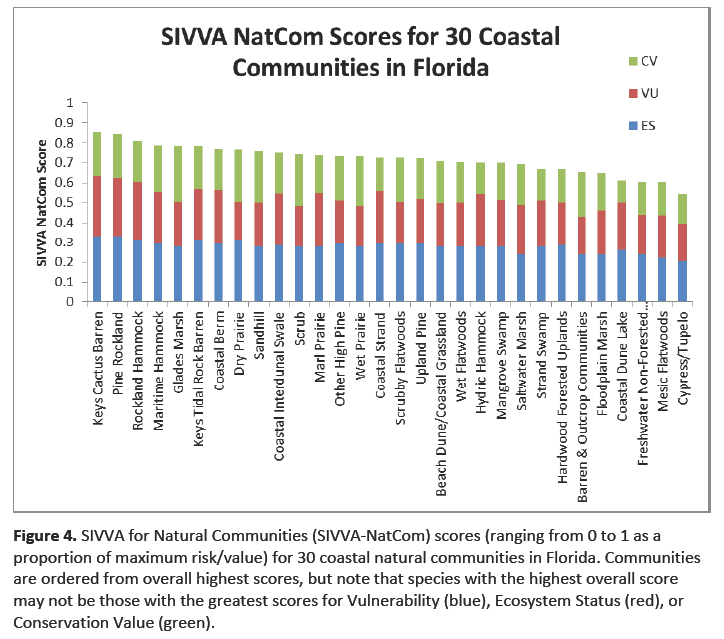- Natural Communities
Standardized Index of Vulnerability and Value Assessment (SIVVA) - Natural Communities
This vulnerability assessment is a spreadsheet-based vulnerability assessment tool that uses a mix of quantitative and qualitative criteria that can be adapted to fit the nature of the vulnerability assessment.
The SIVVA-NatCom analyses evaluated the natural communities tracked by the Florida Natural Areas Inventory (FNAI), cross-walked with Florida Wildlife Conservation Commission (FWC) State Wildlife Action Plan natural community categories. Following the SIVVA report, 15 Conservation Assets were identified by the Peninsular Florida Landscape Conservation Cooperative (PFLCC) as the set of biological, ecological, and cultural features most important for Florida’s Landscape. They represent the most significant resources, embody key landscape components, and reflect the mission, vision, common interests, and values of the PFLCC partners.
This tool contains 31 Florida habitats grouped within the 15 Conservation Assets.
Explore:
Learn more about the SIVVA methods and vulnerability levels.
You can also see specific vulnerability assessment results for the natural communities included here on their profile pages.
Overall Results
Natural communities in southern Florida are generally more vulnerable, especially those in the Florida Keys. These results are intuitive as natural communities in fragile coastal ecosystems will face the most significant impacts from sea level rise and related effects. Also, the SIVVA analysis overlays sea level rise modeling with land use change so coastal natural communities with the ability to migrate north and/or inland, such as mangroves, may not be as vulnerable. Many natural communities in southern Florida are already rare and fragmented, and thus are extremely vulnerable to sea level rise when considered along with expected land use change. The communities with the highest overall relative vulnerability score include:
Keys Tidal Rock Barren
The Keys tidal rock barren community is at high risk of complete habitat loss, with 100% of the current area likely to be inundated by a 1 m rise in sea level. The plants found here are already highly adapted to isolated patches and high salinity levels. However, due to the isolated and patchy nature of this community and its association with flat exposed limestone, it is not likely that it will be able to successfully migrate inland to new suitable sites as sea levels rise. Read more...
Pine Rockland
Pine rockland habitat is likely to have 81% of the current area inundated by 1 m of sea level rise and 99% inundated by 3 m of sea level rise. Altered fire regimes or the absence of fire, along with other climatic changes, could lead to compositional and structural changes, potentially altering suitability to the current suite of species. Read more...
Rockland Hammock
Florida's rockland hammock habitat is likely to have 58% of the current area inundated by 1 m of sea level rise and 91% inundated by 3 m of sea level rise. Increased soil salinity from saltwater intrusion and increased length of root inundation, increased exposure of salt spray and coastal erosion will lead to changes in species composition and structure as salt intolerant plants decline and plants with higher salt tolerances increase. Read more...
Maritime Hammock
Maritime hammock is likely to have 61% of the current area inundated by 1 m of sea level rise and 94% inundated by 3 m of sea level rise. Increased soil salinity will lead to changes in species composition and structure as salt intolerant plants decline and plants with higher salt tolerances increase. Coastal forests are already being impacted by saltwater intrusion, longer periods of root inundation, salt spray, and coastal erosion. Read more...
Glades Marsh
Glades marsh is likely to have 30% of the current area inundated by 1 m of sea level rise and 92% inundated by 3 m of sea level rise. Decreased precipitation coupled with increased temperature will likely alter species composition and increase fragmentation of larger systems through reduced flow and connectivity. Read more...
Learn more about climate impacts to ecosystems and habitats in Florida.
Detailed Results

Methods
Natural communities were evaluated using the following criteria:
-
Ecosystem Status: assesses the historical decline in extent and ecosystem function.
-
Vulnerability: accounts for quantitative estimates of area lost directly to sea level rise, land-use change, and fragmentation as well as vulnerability to altered disturbance regimes, hydrology, invasive species, constraints on the ability of the system to shift in response to threats, and other factors that degrade abiotic or biotic components of the ecosystem.
-
Conservation Value: considers factors such as presence of endemic species or habitats, evolutionarily distinct species and the value of ecosystem services provided by the natural community. Results are discussed under a value scheme that places equal emphasis on each of the three components.